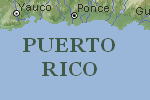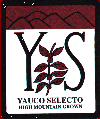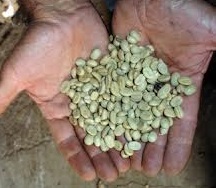Main menu:
Puerto Rico
Introduction |
|
Flag: |
|
Card: |
|
Background: |
Discovered by Columbus in 1493, the island was ceded by Spain to the US in 1898 following the Spanish-American War. A popularly elected governor has served since 1948. In plebiscites held in 1967 and 1993, voters chose to retain commonwealth status |
Geography |
|
Location: |
Caribbean, island between the Caribbean Sea and the North Atlantic Ocean, east of the Dominican Republic |
Geographic coordinates: |
18 15 N, 66 30 W |
Map references: |
Central America and the Caribbean |
Area: |
total: 9,104 sq km |
Land boundaries: |
0 km |
Coastline: |
501 km |
Maritime claims: |
exclusive economic zone: 200 NM |
Climate: |
tropical marine, mild; little seasonal temperature variation |
Terrain: |
mostly mountains, with coastal plain belt in north; mountains precipitous to sea on west coast; sandy beaches along most coastal areas |
Elevation extremes: |
lowest point: Caribbean Sea 0 m |
Natural resources: |
some copper and nickel; potential for onshore and offshore oil |
Land use: |
arable land: 4% |
Irrigated land: |
390 sq km (1993 est.) |
Natural hazards: |
periodic droughts; hurricanes |
Environment - current issues: |
erosion; occasional drought causing water shortages |
Geography - note: |
important location along the Mona Passage - a key shipping lane to the Panama Canal; San Juan is one of the biggest and best natural harbors in the Caribbean; many small rivers and high central mountains ensure land is well watered; south coast relatively dry; fertile coastal plain belt in north |
People |
|
Population: |
3,937,316 (July 2001 est.) |
Nationality: |
noun: Puerto Rican(s) (US citizens) |
Ethnic groups: |
white (mostly Spanish origin) 80.5%, black 8%, Amerindian 0.4%, Asian 0.2%, mixed and other 10.9% |
Religions: |
Roman Catholic 85%, Protestant and other 15% |
Languages: |
Spanish, English |
Government |
|
Country name: |
conventional long form: Commonwealth of Puerto Rico |
Dependency status: |
commonwealth associated with the US |
Government type: |
Commonwealth |
Capital: |
San Juan |
Flag description: |
five equal horizontal bands of red (top and bottom) alternating with white; a blue isosceles triangle based on the hoist side bears a large, white, five-pointed star in the center; design influenced by the US flag, but based on the Cuban flag |
Economy |
|
Economy - overview: |
Puerto Rico has one of the most dynamic economies in the Caribbean region. A diverse industrial sector has surpassed agriculture as the primary locus of economic activity and income. Encouraged by duty-free access to the US and by tax incentives, US firms have invested heavily in Puerto Rico since the 1950s. US minimum wage laws apply. Sugar production has lost out to dairy production and other livestock products as the main source of income in the agricultural sector. Tourism has traditionally been an important source of income, with estimated arrivals of nearly 5 million tourists in 1999. Prospects for 2001 are clouded by a probable slowing down in both the construction and tourist sectors and by increasing inflation, particularly in energy and food prices; estimated growth will be 2%. |
Currency: |
US dollar (US) |
Currency code: |
USD |
Exchange rates: |
the US dollar is used |
Transportation |
|
Railways: |
total: 96 km |
Coffee |
|
|
|
|
|
Cup taste: |
The coffee from Puerto Rico is mild by nature, rich and has a full body. The taste is fruity with a slight spiciness, the acid is tender. The taste is complemented by a touch of dark chocolate. |
The main customers: |
USA, Frankreich, Japan |
Qualities: |
washed Arabica |
Classification: |
mounting height |
Harvest: |
September bis March |
Port of Export: |
San Juan |
Production: |
45.000 Säcke (à 60 kg) |
|
|















